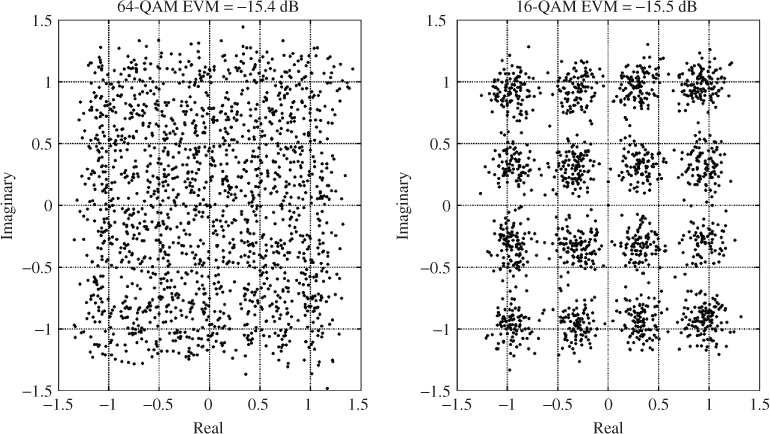3.7 Adaptive Modulation Illustration
In this brief section we aim to illustrate the impact of the receiver EVM on the different constellations used in Mobile WiMAX and the advantage of using adaptive modulation. The principle of adaptive modulation is to create a loop between the transmitter and the receiver in order to optimize the communication to the channel properties, that is, link quality. The goal is to allow the receiver to always demodulate the data at a specified BER by adapting the transmission modulation order, that is, the data-rate, to the received EVM.
For example, we show in Figure 3.65 the 64-QAM and 16-QAM constellations demodulated with an EVM around −15 dB. We can see that the 64-QAM constellation is difficult to distinguish and we can predict that the receiver will be unable to assure a BER of 10−6 with this modulation order because the EVM is below the minimum requirement defined in Table 3.3. On the other hand, by lowering the transmitter modulation order to 16-QAM, then for the same EVM the individual constellation points can be clearly observed allowing the receiver to achieve a BER of 10−6, albeit at a lower data-rate.
Figure 3.65 Adaptation of the modulation from 64-QAM to 16-QAM

Figure 3.66 shows the same principle when switching from 16-QAM to 4-QAM at the point where the EVM is such that the receiver is unable to correctly demodulate 16-QAM.
Get RF Analog Impairments Modeling for Communication Systems Simulation: Application to OFDM-based Transceivers now with the O’Reilly learning platform.
O’Reilly members experience books, live events, courses curated by job role, and more from O’Reilly and nearly 200 top publishers.

